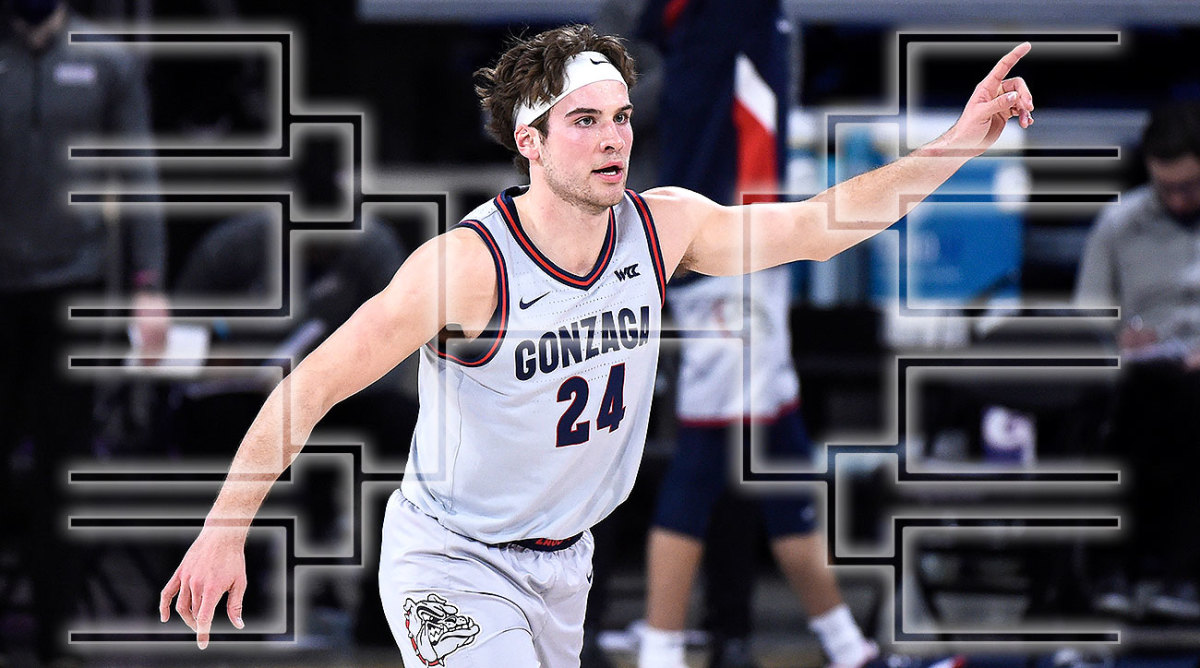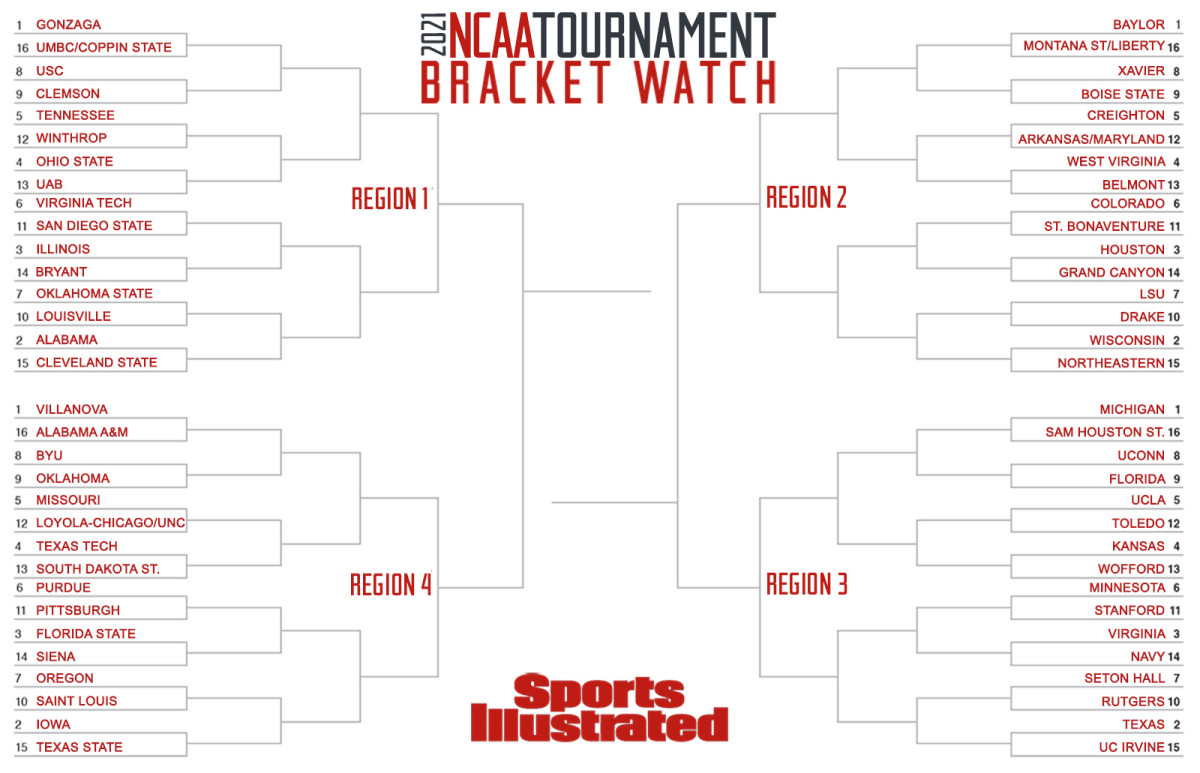Bracket Watch: SI's First Look at the 2021 Projected Field of 68

It’s officially time to start looking at brackets. Selection Sunday is now less than seven weeks away, and with conference play in full swing, teams finally have a full enough sample size to start evaluating them. Still, a season unlike any other will have bracket challenges unlike any other. COVID-19-related pauses and cancellations mean that teams will have far more variance in the total number of games they played. Abbreviated nonconference schedules make it tougher to compare teams across leagues and make key metrics more volatile (see Colgate’s No. 13 ranking in the NET).
How will the committee address these issues? We have more questions than answers at this point. And things will only get more complicated if dominos begin to fall regarding potential conference tournament opt-outs. One thing will be simplified from a normal year: With every team headed to Indiana (the state will host the entire 2021 men's NCAA tournament), the teams will be bracketed based entirely on an S-curve of the seed list with exceptions to avoid rematches.
Let’s break down the men's field of 68 as I see it now:

Bubble
Last Four Byes:
Rutgers
Stanford
San Diego State
Pittsburgh
Last Four In:
Arkansas
Utah State
Maryland
North Carolina
First Four Out:
Indiana
Syracuse
Loyola-Chicago
Marquette
Next Four Out:
Michigan State
Georgia Tech
Providence
SMU
Big Ten action this past weekend had significant impacts on the bubble. Maryland sits precariously close to the .500 threshold, but a Saturday road win at Minnesota gives the Terps three elite wins (at Illinois, at Wisconsin) and a spot in the field. Meanwhile, Sunday's Rutgers-Indiana matchup became something of a play-in game, with the Scarlet Knights' road win at Assembly Hall enough to secure their spot in the field. Teams like Maryland, Indiana and Rutgers will certainly compile more quality wins because of the Big Ten’s strength, but can they win enough total games to stay above .500?
* = team is projected to win its conference's automatic bid
Gonzaga Region
No. 1 Gonzaga* vs. No. 16 UMBC*/Coppin State*
No. 8 USC vs. No. 9 Clemson
No. 5 Tennessee vs. No. 12 Winthrop*
No. 4 Ohio State vs. No. 13 UAB*
No. 6 Virginia Tech vs. No. 11 San Diego State
No. 3 Illinois vs. No. 14 Bryant*
No. 7. Oklahoma State vs. No. 10 Louisville
No. 2 Alabama* vs. No. 15 Cleveland State
Since we don’t have traditional geographical region names this year, we’ll name these regions based on their No. 1 seed. Gonzaga easily snags the top overall seed, and fast-rising Alabama claims the final No. 2 seed. Meanwhile, I’m keeping a keen eye on Tennessee after the Vols have lost back-to-back games. Rick Barnes’s team has a clean résumé, with no losses outside of Quad 1 (Q1) and a couple of quality wins, but needs to turn around this midseason swoon.
Also worth noting is Oklahoma State’s inclusion—the Cowboys were banned from the postseason due to the fallout from the FBI’s investigation into college basketball, but that ruling is currently in the appeals process and OSU is viewed as eligible until a final decision is made.
Baylor Region
No. 1 Baylor* vs. No. 16 Montana State*/Liberty*
No. 8 Xavier vs. No. 9 Boise State*
No. 5 Creighton vs. No. 12 Arkansas/Maryland
No. 4 West Virginia vs. No. 13 Belmont*
No. 6 Colorado vs. No. 11 St. Bonaventure*
No. 3 Houston* vs. No. 14 Grand Canyon*
No. 7 LSU vs. No. 10 Drake*
No. 2 Wisconsin vs. No. 15 Northeastern*
This region features two current auto-bids who will be fascinating to watch as potential at-large candidates in Boise State and Drake. The NET loves both clubs, with Drake ranked No. 12 as of Monday and Boise in just behind it at No. 15. On the other hand, both teams lack quality wins—Drake hasn’t played a single Q1 game and Boise is just 1–1 vs Q1. The Broncos should have plenty of opportunities in league play thanks to a backloaded Mountain West schedule, and its win at BYU is aging like fine wine. Drake might not be so lucky if it can’t win the Missouri Valley tournament.
Michigan Region
No. 1 Michigan* vs. No. 16 Sam Houston State*
No. 8 UConn vs. No. 9 Florida
No. 5 UCLA* vs. No. 12 Toledo*
No. 4 Kansas vs. No. 13 Wofford*
No. 6 Minnesota vs. No. 11 Stanford
No. 3 Virginia* vs. No. 14 Navy*
No. 7 Seton Hall vs. No. 10 Rutgers
No. 2 Texas vs. No. 15 UC Irvine*
The current Big Ten leaders in Ann Arbor are on pause due to a health department order stemming from confirmed cases of the ‘U.K. Variant’ of COVID-19 in the Michigan athletic department, but they still sit on the No. 1 line for now. Stanford earned its way into the field with its win over UCLA on Saturday. But the real headliner out of this region is the first-round rivalry matchup between Seton Hall and Rutgers. The two teams couldn’t play this year due to scheduling challenges, but a matchup like this in March would set the state of New Jersey ablaze.
Villanova Region
No. 1 Villanova* vs. No. 16 Alabama A&M*
No. 8 BYU vs. No. 9 Oklahoma
No. 5 Missouri vs. No. 12 Loyola-Chicago/North Carolina
No. 4 Texas Tech vs. No. 13 South Dakota State*
No. 6 Purdue vs. No. 11 Pittsburgh
No. 3 Florida State vs. No. 14 Siena*
No. 7 Oregon vs. No. 10 Saint Louis
No. 2 Iowa vs. No. 15 Texas State*
Florida State’s January surge makes it the second ACC team on the No. 3 line after winning its last four games by an average of 17.8 points. It will be fascinating to see whether the Seminoles can keep it up once they leave Tallahassee—a recent win at Louisville is their only road win on the season. Meanwhile, Saint Louis will be an interesting potential bubble team to track after sitting out for more than a month due to an extended COVID-19 pause. The Billikens earned some big wins in nonconference play, but it seems unlikely they’ll play anything close to a full Atlantic 10 schedule.
Sweeney's full projected bracket, as of Jan. 26:

